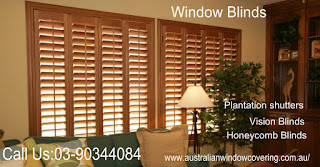Window Blinds are the linings used for windows to give shade and privacy to their place, usually attached to the interior of the window. The good thing about using these blinds is that you can control the amount of light that enters by simply adjusting the blinds.
Types of blinds:
The blinds are of different types:
Blinds: These blinds have many flat and horizontal slats, which are connected by a rope to be rotated. This allows light to pass between the slats. To keep the light off, you can rotate it 170 degrees or clear it from the window. When pulling a cable or rotating a connector that is connected to the rope, you can perform the rotation and use a different chain to raise and lower the blinds. There are other versions where the two mechanisms are combined in a single rod. The Lamella blinds include:
 |
| Honeycomb Blinds |
Venetian blinds: introduced around 1770 in Venice, these blinds are made of plastic or metal, and sometimes even the wooden slats are called blinds in wood or bamboo. The width of the strip is between 50 and 120 mm.
Mini blinds: they are essentially Venetian blinds that have slats that measure only 19-24 mm.
Vertical Blinds: These blinds use horizontal plastic or metal sheets that can rotate ninety degrees to allow light to enter, or they can be folded to the side for a clear view through the window.
Solid blinds: often called blinds, these blinds, unlike Venetian blinds, cannot be turned. But they can be rolled or folded to allow light to enter. These stores include:
Vision Blinds: Vision blinds are an excellent alternative to the classic Venetian blind or roller, which combines the perfect balance of intimacy and light control with the trend of fashion, with its bold stripes and color blocking.
Dutch blinds: known as roller shutters because they have roller shutters that can be lowered.
Braided wood blinds: the slats used are decorative wood or bamboo, which are woven together with colored threads or other decorative materials. These blinds can be rolled or folded. They are energy efficient, have better light control and are economical alternatives to the shutters.
Pleated blinds: these blinds consist of folded fabric fabrics that can be raised to the top of the window.
Plantation shutters: Plantation shutters are a type of window treatment that consists of wooden shutters or fake wood mounted in a solid frame. The blinds are manipulated by a tilt rod hidden in the back or in the middle of the shutter.
Honeycomb blinds or cellular shutters: they are similar to pleated blinds, but here, there are two or more joints joined in the folds that form compartments to trap the air, which saves the room in your energy bills. Cell tones come in a variety of styles, such as double and triple styles.
Roman blinds: these blinds have a cord woven through the fabric that allows you to raise or lower the curtain in an accordion pattern. They are easy to use and are very effective in isolation.
When installing your blinds, you must ensure that the blinds are not obstructed so that, when fully extended, they can hang freely. It is necessary to cut the blinds so that they enter the windows. You must measure the width and length correctly before cutting the blinds. You can also place the blinds in the windows of your bathroom. Choose pleated or cellular shutters with privacy protection to prevent people from looking out their windows.
You can choose the blinds that suit you in the variety of window blinds available in Australian window covering Melbourne. The blinds Melbourne are extremely beneficial, not only to protect against sunlight, but also to prevent viewers from looking through their windows.
No comments:
Post a Comment